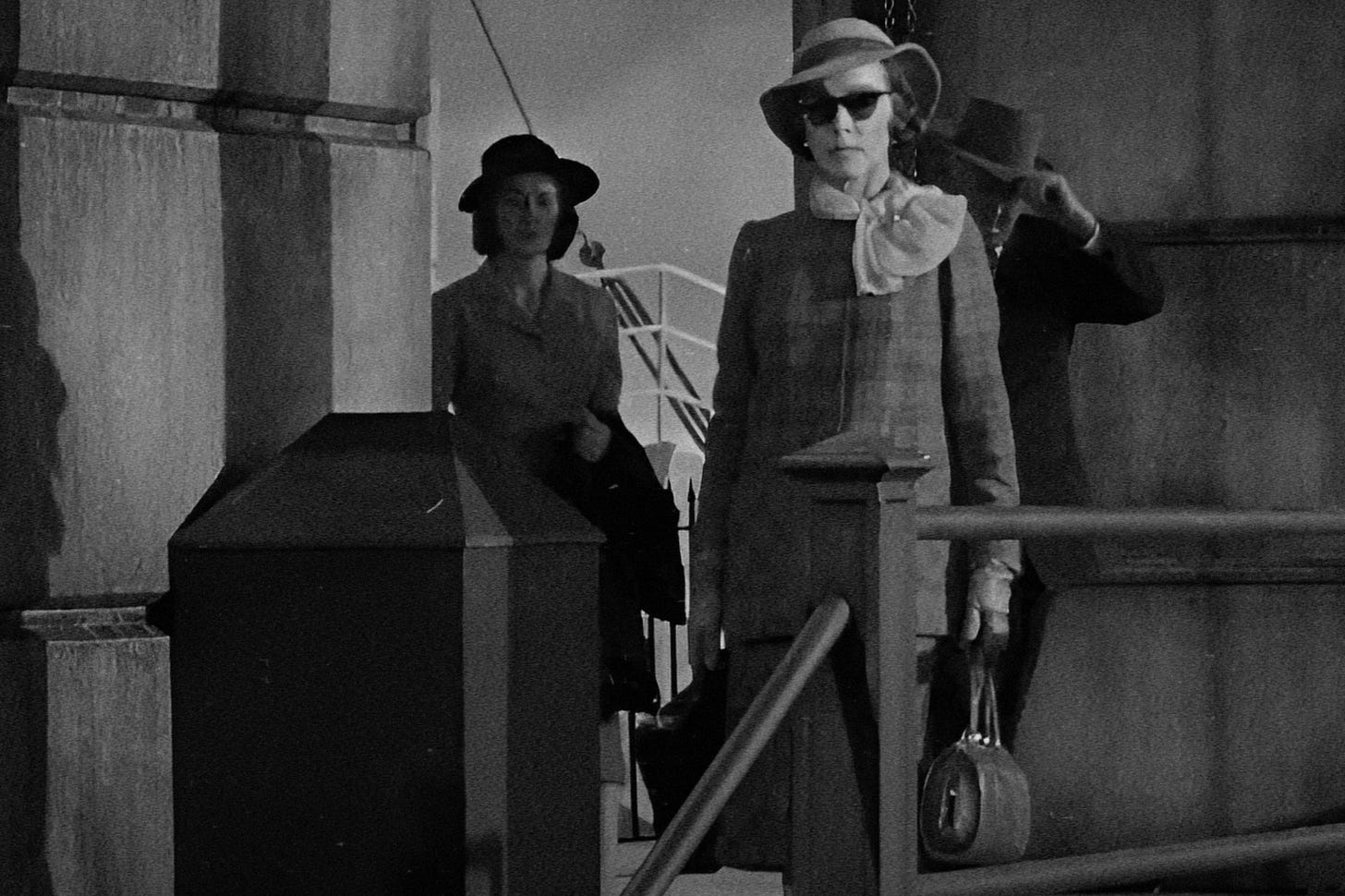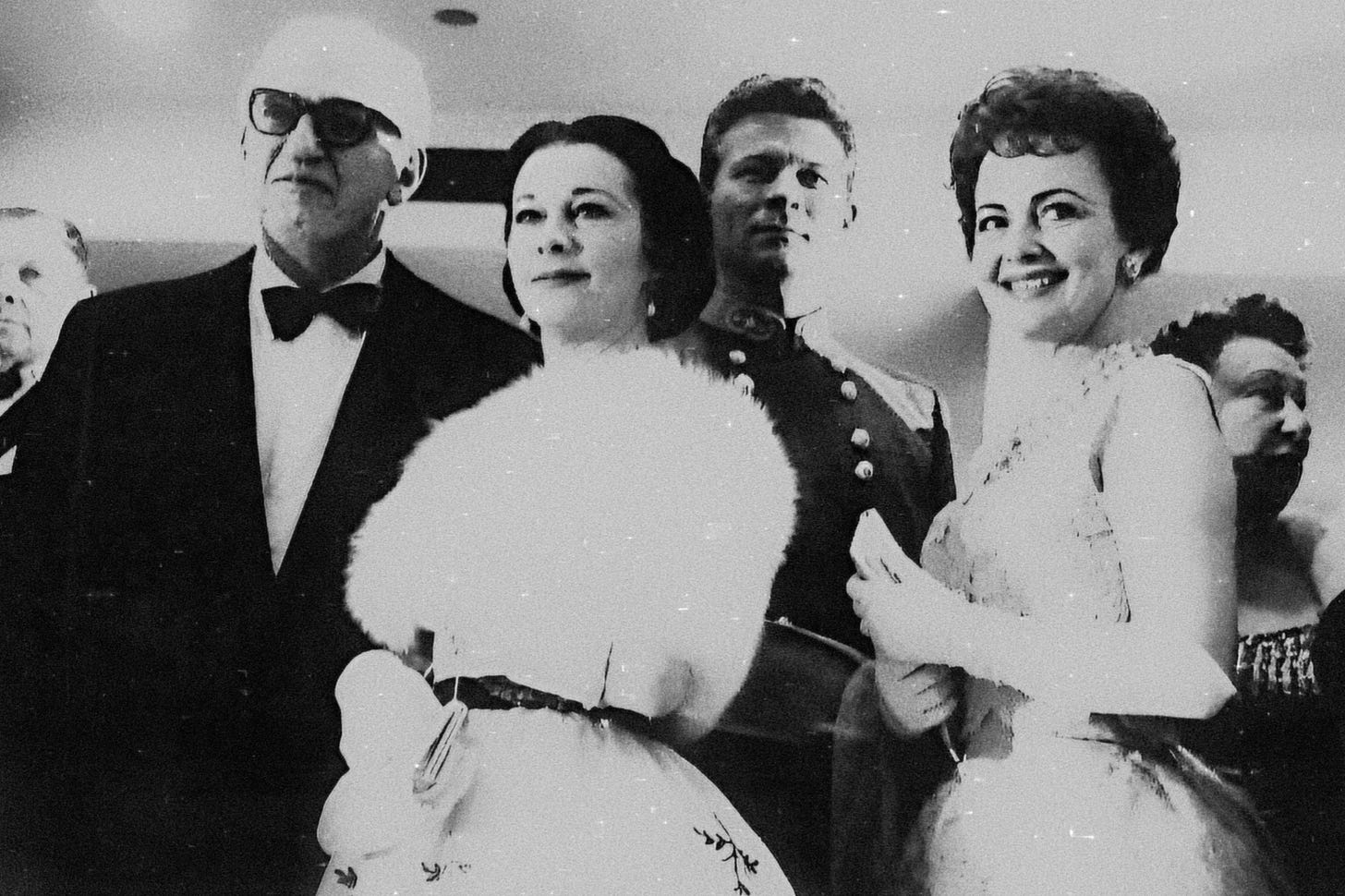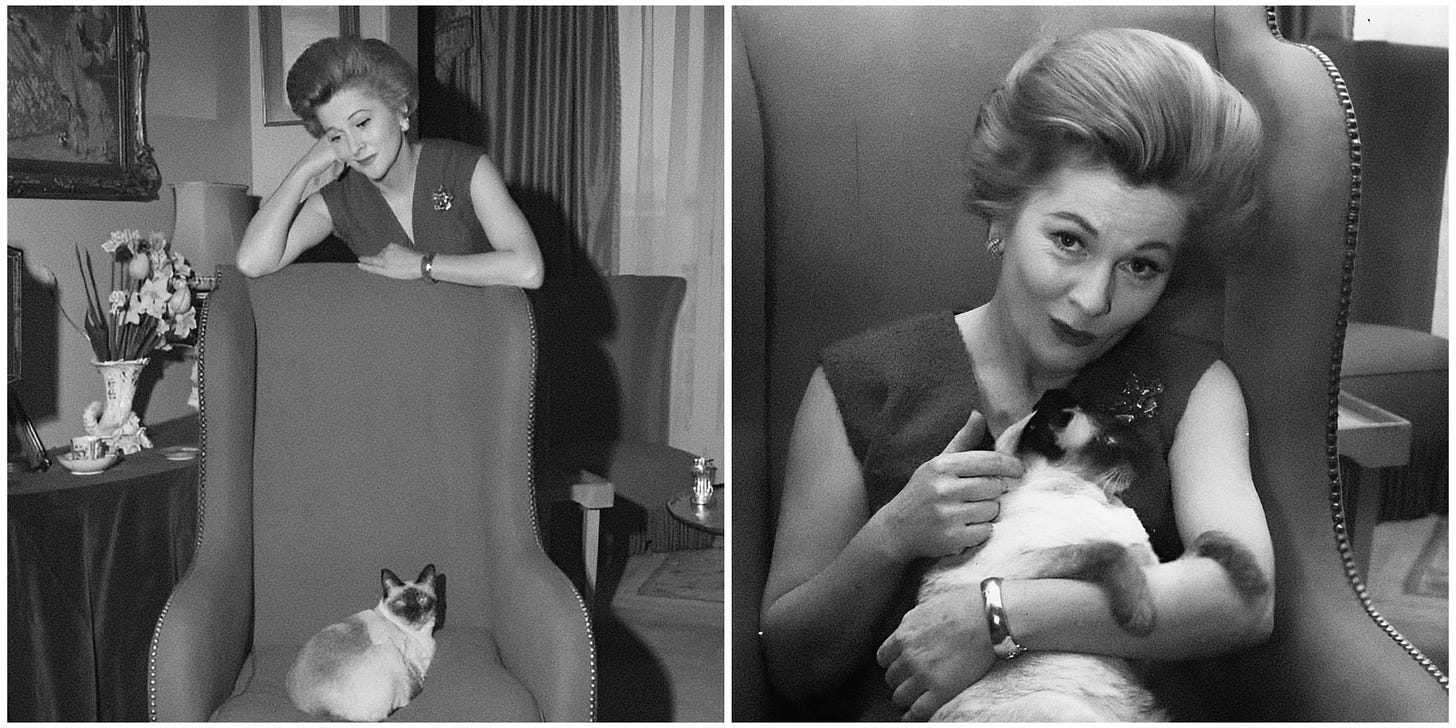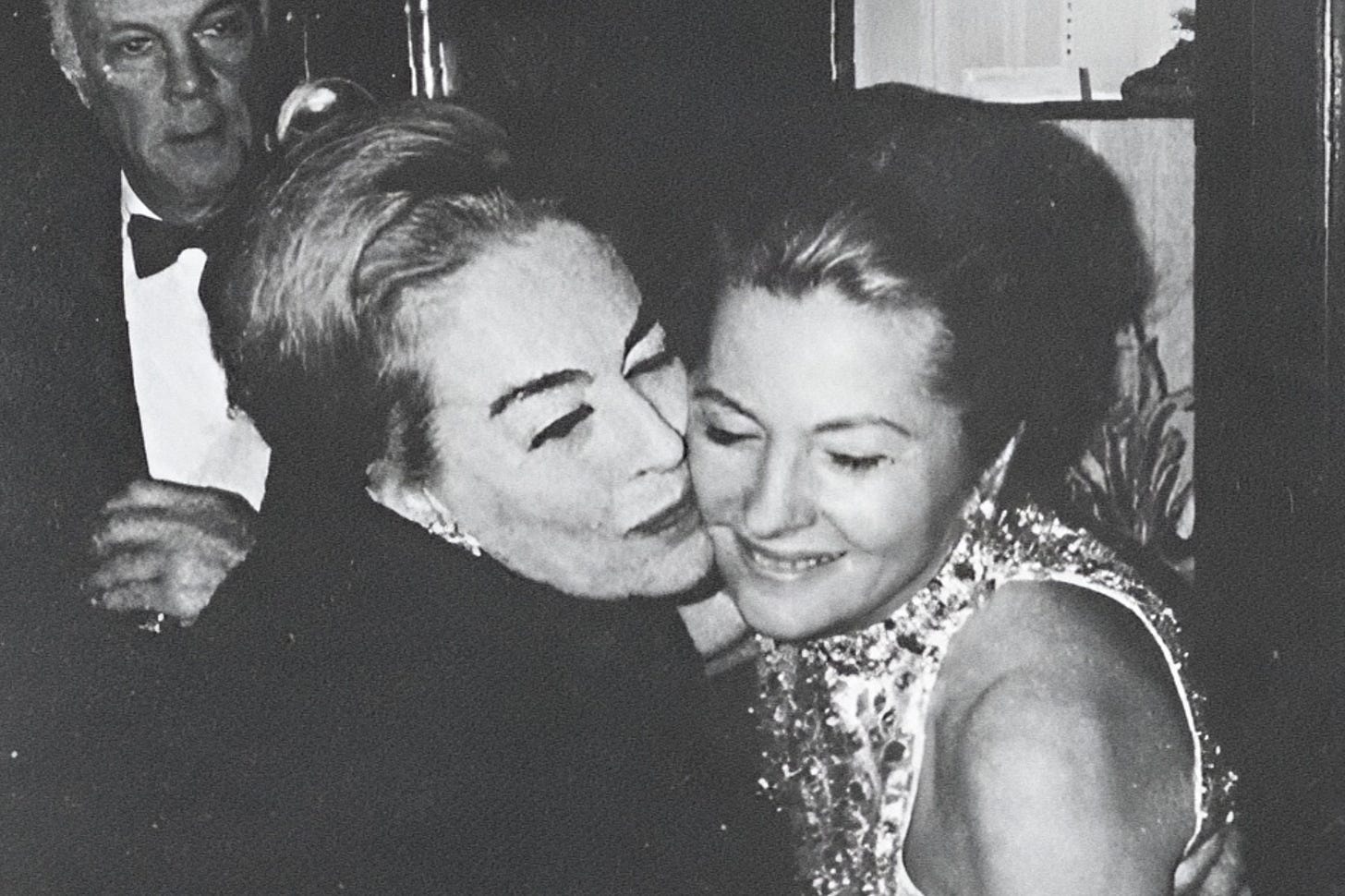Fagsploitation
This week’s article concerns Hollywood’s psycho-biddies: from Joan Crawford to Demi Moore -- and how their late-career struggles mirror our experience of rejection.
I’m not up on horror pictures.
A “cultural” – although heaven knows there’s more culture in a yoghurt than my sensibilities – blindspot. Most of you set great store by them! I’ve never seen the appeal. It’s a low-rent genre, in my view. Discounting Rosemary’s Baby or Misery or Mame.
Many actresses end their filmographies in gothic cinema. Showing, like Demi Moore, that portraying older women as unhinged needn’t overshadow their earlier work. Moreover, it furnishes a third act that otherwise eludes them. From Whatever Happened to Baby Jane? to The Substance, subversive themes meet camp aesthetics. “Hagsploitation” or, more politely, the “psycho-biddy”. An embrace of the “other” that speaks to our feelings of marginalisation.
Vivien Leigh’s final screen appearance came in 1965’s Ship of Fools, a bone-dry but respectable chamber piece. Grand Hotel on a transatlantic liner not named “Titanic”. Ms. Leigh, who’d live another two years, acted under considerable duress. Her bipolar disorder alienated the director and most of her co-stars. Still, it’s Viv’s performance that lends this forgotten Best Picture nominee prestige. In the final scene, she disembarks: head held high. Having just seen off a molester with her kitten heel, she crosses the gangplank with poised resolve. (Her mania was such that this weapon drew blood, though Lee Marvin gallantly requested she sign the shoe as a keepsake.) It wasn’t the worst way to conclude her career.
Had Vivien succeeded Joan Crawford in Hush…Hush, Sweet Charlotte, her exit would’ve been much less dignified. Which here means: “being crushed under a potted plant dumped by Bette Davis”. By declining, Scarlett O’Hara protected her legacy.
Enter Melanie Wilkes.

Miss Olivia de Havilland, Bette’s Warner Brothers confrère, was summoned. Novelist Marcus Goodrich, de Havilland’s first husband, added the “Miss Olivia” during 1952’s My Cousin Rachel, another part she inherited from Vivien. “Livvie”, her long-standing nickname, was inappropriate for a “mid-century Duse” who’d won two Oscars within three years – or so co-star Richard Burton gibed. Joan Fontaine was less sanguine. “It’s too bad Livvie’s husband has had four wives and only one book!”
De Havilland’s late-career turn in Charlotte accompanied Lady in a Cage, The Screaming Woman and The Swarm. However, living until 2020, she had ample opportunity to reframe her low points. So did Joan Fontaine (d. 2013). At the time I speak of now, she was making British schlock. Indeed, she was living in Vivien Leigh’s flat! Vivien, performing in New York, agreed to house-swap with Fontaine – expected at Hammer’s Berkshire studios. Everyone cautioned against this, but Viv couldn’t be told. Livvie de Havilland was the sweetest girl in the world. How bad could her sister be?

In her 1978 memoir, No Bed of Roses (aka No Shred of Truth), Joan Fontaine paints an unflattering image of Vivien’s apartment and maid. Both reeking of “feline proximity”, she was greeted by a litter tray that hadn’t been changed in weeks. A bum deal, Joan groused. After all, she’d left Vivien a “superb Jamaican housekeeper” and the use of her fine linens and crockery on the Upper East Side. “Her Ladyship”, Joan claims, forbade her from even housing her Alfa Romeo in the unoccupied garage. Cat-smell soon permeated everything, from her car to her clothes. After refusing breakfast, Fontaine gagged to work in a hired, but sterile, Daimler.
Joan couldn’t escape stinking Belgravia quick enough. Evicting Vivien from East 72nd Street? Nigh on impossible. “What am I to do?” Ms. Leigh carped. A melodrama heightened by the fact that her Broadway play had long closed. “Throw my luggage into the street?” Vivien eventually returned to London to find watches missing, despite Joan’s informal rental agreement requiring valuables to be stored.
Those of us who’ve paid the princely sum of a hair transplant to be labelled “just wanting to be trendy” (sorry, combination autism-ADHD) understand the pang of losing things. Vivien, suffering a more callous form of psychiatric misdiagnosis, knew it well. A lifelong impulsivity that frequently led to misplaced possessions. Vivien additionally endured several high-profile burglaries – through no fault of her own. Her original Oscar statue for Streetcar was one casualty, although she repeatedly pleaded with thieves to return only small, sentimental pieces. The watches had been a gift of Larry’s.
Joan’s yarns of being hauled before the FBI and defamed for stealing jewellery seem petty. In any case, Fontaine reports, the authorities treated this investigation as a formality. They’d humoured Vivien’s vexatious accusations before. Viv’s biographers tell a different story. In the Leigh camp, Joan Fontaine left 54 Eaton Square one day and never returned. Only later did they notice the cherished timepieces had gone with her.
And if you believe that, you’ll believe anything!

This much is true. A quarter-century after Vivien Leigh eclipsed all but, as Rosalind Russell noted, “Lassie and Mrs. Roosevelt” for Gone With the Wind, Scarlett hopefuls, now in the autumn of their lives, competed for scraps. Primarily in hag horror – unless they took the prudent approach of marrying rich. Greer Garson wed a Texas oil man. Norma Shearer, with her Thalberg inheritance, tied the knot with her ski instructor. Joan Crawford, a soft-drink tycoon. Sadly, Mr. Pepsi’s reputation belied debt and tax obligations, and when her profligate cola baron died in 1959, Joan was left picking up the Tab.
There was no room for Crawford to voice outrage at the hand life dealt her. Nor Bette Davis. With characteristic sadism, the tabloids contrasted their desperation for relevance with the aloof dignity of Katharine Hepburn. A far cry from their Depression salad days, when Disney borrowed Crawford’s likeness for Snow White’s evil queen. A time when both Joan and Kate were branded “box-office poison”; and were determined to remain fairest of them all. (Bette, meanwhile, soared in this period. She earned five consecutive Best Actress nominations and two wins.) Three decades on, it was Hepburn, and Hepburn alone, who triumphed.
As Spencer Tracy’s unofficial widow – and lacking the burden of ungrateful adult daughters – Katharine, less versatile than either, could prove her actorly mettle. She tackled Euripides, Edward Albee and Tennessee Williams. She was the improbable star of a musical about Coco Chanel. (In Paris, you can guess to which Hepburn they assumed “Mademoiselle” referred.) On screen, she sparred with Laurence Olivier and John Wayne. She even took one of Bette’s old Warner turkeys, The Corn Is Green, and turned it into a well-regarded TV movie. What’s more, for a woman who’d spent thirty-four years out of Oscar’s good graces, she won three (well, two-and-a-half) within the next fourteen.

The more things change, the more they stay the same. During the COVID-19 pandemic, Sharon Stone went viral for condemning the narrative that pits women against each other and elevates a single star to sainthood. “Only Meryl [Streep] got to be the good one.”
Stone’s remarks were roundly denounced, but drew quiet admiration online. The knives were out when Angela Bassett, a person of colour, added to the refrain. Her pride in gracefully handling her 2023 Oscar loss – “a given”, she sighed – was at odds with the sour-faced, but human, reaction one can easily see on YouTube. (“[It’s] interesting that I wouldn’t be allowed to be disappointed at an outcome where I thought I was deserving.”) Demi Moore invited similar scrutiny. At last week’s TIME100 Gala, Moore was philosophical about her recent defeat. “When I look at it through that lens, it allows me to step back and say, “What is this trying to give me?”.”
We can be stoic. Never bitter.

A drive for validation connects us all. It transcends gender, race, class, and sexual orientation. I’ve always struggled with “glennvy”. Why do you think Ms. Close is my Number One Lady? If she’d won that golden dildo, I wouldn’t give her a second thought! But seeing the Academy humiliate a kindly septuagenarian and great artist upsets me.
Demi Moore sat in the same seat on Oscar night, six years post-The Wife. Mercifully, she sported silver. Glenn’s Ferrero Rocher look rubbed salt into the wound in 2019. Grub Street, remember, celebrated Glenn Close and Demi Moore’s losses, not Othiefia Stoleman and Mikey Madison’s wins. Relishing lamé-clad boomer hubris being taken down a peg or two. Considering Glenn and Demi’s privilege, fortunes, and connections, one should be indifferent to their plight. I am not! Their snubs resonate because they feel emblematic of larger things.

“Bitterness is drinking poison and expecting the other person to die.” The Alcoholics Anonymous axiom that Carrie Fisher, whose picture opened this article, popularised. The image is from Scream 3, a horror picture, in which she deliciously sends herself up as a scathing secretary. A harridan still nursing her Star Wars loss, a lifetime ago. As Princess Leia’s doppelganger, this lowly pen-pusher is limited by the chances she missed. Another Fisher proverb I frequently return to is “Celebrity is just obscurity biding its time”. Perhaps jealousy is admiration we haven’t processed?
Wouldn’t you, like Joan Crawford, jump at the first role that promises temporary security? It’s a precarious world out there. Not that I see Glenn Close, Vivien Leigh, or the Joans as stand-ins for my frustrations. Like you and I, these actresses fought to define their lives on their terms. It’s why I shun the horror pictures in which they ultimately landed. My scorn for the genre reflects the fear that I, too, have been sidelined.
Time moves on, but people don’t.
Read Next:
Viv, Larry, and the Great Anglo-American Film War
Richard Chamberlain and the Politics of Outing
I Know Why the Songbird’s Caged
Cottagecore: Or How Sir John Gielgud Went to the Gents’ and Almost Lost It All






Educational and hilarious, per always, Mark! (I’ll be naming my next pug “Hepburn”, the ambiguity of which will serve as a litmus test of taste.) I suddenly have a hankering for a Tab™️… 🩷
I'm not up on horror pictures, either, but find it so droll that you include Maimed in their number. After living in NYC for half a century, I got to see a lot of classic era movie stars in person, and by far the scariest of them all was Lucille Ball. She looked great but she behaved like like one of the generals in Dr. Strangelove. Ball's other turn in the hagsploitation genre occurred in 1985 with the made for TV film Stone Pillow. Kate Hepburn escaped that curse just as she escaped being outed as a Lesbian for over 75 years. Cheers to you dear Mark, you're never too young to be eccentric, just ask Tallulah Bankhead.